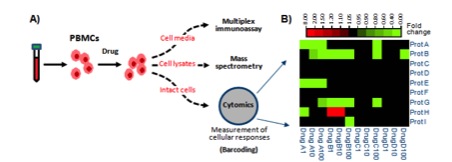The development of novel drugs for psychiatric illnesses has come to a standstill due to difficulties of classifying symptoms and an inadequate understanding of the affected molecular pathways in patients. Recent studies indicate that data with high translational relevance can be obtained using biological samples such as blood serum and cells, which can be obtained directly from patients. Serum contains molecules such as hormones and cytokines, which can act as molecular readouts of brain function and peripheral blood cells (PBMCs) express important targets which are found in the brain including neurotransmitter, hormonal and cytokine receptors, and the corresponding signalling pathways.
We are testing such cells using a novel cytomics drug screening platform. This uses reporter systems for activation of receptor signalling cascades involved in both physiological and dru-induced responses. Disease signatures can be identified by comparison of specific cellular responses to drug treatment using PBMCs from psychiatric patients and controls. Testing can also be carried out after addition of current psychiatric medications or potential novel therapeutic approaches (Figure). Taken together with traditional proteomic signatures obtained by liquid chromatography mass spectrometry profiling analysis of cell lysates and multiplex immunoassay profiling of cell supernatants, this could lead to a preclinical model with companion biomarker read-outs for use in studies of psychiatric disorders and in the discovery of new drug targets and medications.

A) General scheme to explore functional aspects of drug effects on cells using a combination of proteomic (mass spectometry and multiplex immunoassay) and cytomic methods. B) Generation of cellular barcodes showing impact of different drugs and doses (x-axis) on cytokine response (Prot A-I; y-axis) in PBMCs isolated from control subjects. Drugs were tested for their ability to normalize the proinflammatory response. Comparison of barcodes from control subjects and psychiatric patients can give a new insight into the affected pathways and also identify potential drug targets for development of novel pharmaceutical treatments.

